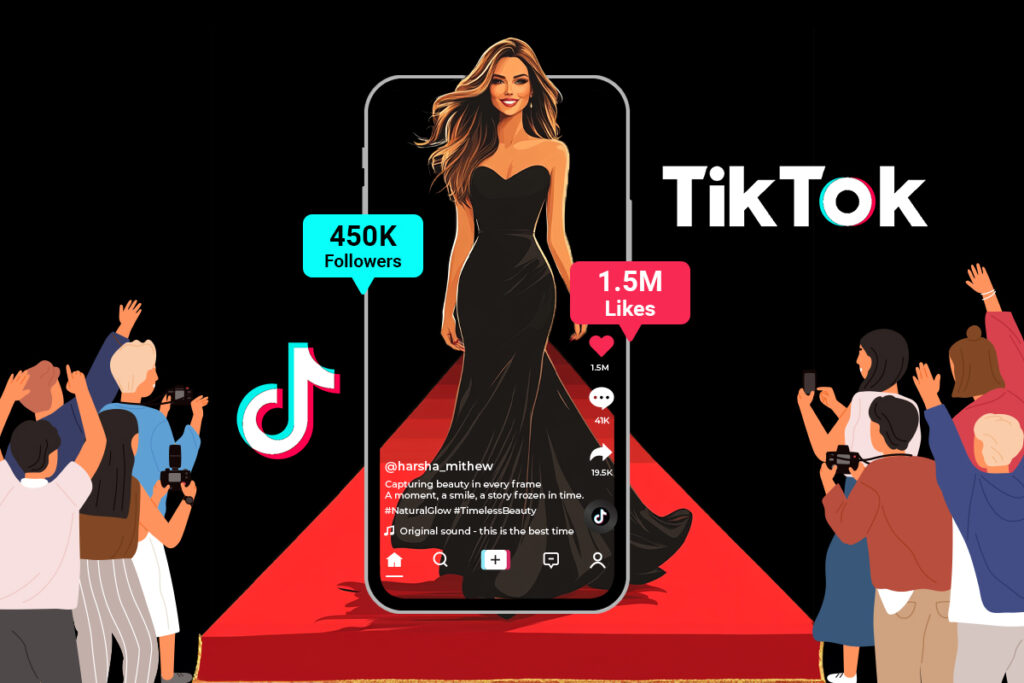A thorough TikTok influencer contract should include legal names, addresses, and contact details of involved parties for accountability. It must define the scope of work, specifying content type, quantity, and style, with set deadlines and approval processes. Compensation terms, including payment timelines, should be clear. Confidentiality, exclusivity clauses, and intellectual property rights must protect brand interests. A dispute resolution framework is essential for addressing conflicts promptly. Amendments must be documented with mutual consent. Finally, detailed content guidelines guarantee alignment with brand standards. With these components, stakeholders cultivate successful partnerships and can appreciate the finer complexities of contract execution.
Key Takeaways
- Clearly outline contract essentials, including legal names, addresses, and effective dates for accountability.
- Define scope of work with content type, quantity, and deadlines for submissions.
- Specify compensation terms, payment timelines, and performance-based incentives for clarity.
- Include confidentiality and exclusivity clauses to protect brand interests and prevent conflicts.
- Detail intellectual property rights outlining content ownership, usage, and modification terms.
Contract Essentials
In the domain of influencer marketing, the cornerstone of a successful partnership is a meticulously crafted TikTok influencer contract. This document serves to delineate the obligations and expectations of both parties involved.
Essential elements start with the inclusion of the legal names and addresses of the influencer and the brand, establishing a clear identity and ensuring accountability. Moreover, the contract must explicitly define its purpose by detailing the specific promotional activities the influencer will undertake. This clarity aids in aligning both parties’ objectives.
Equally important is the specification of the contract’s effective date, marking the commencement of obligations, as well as the duration, which includes start and end dates. This temporal framework is vital for managing expectations and ensuring both parties are committed for the agreed period.
Provisions for contract renewal should also be incorporated, allowing a seamless extension of the partnership should both parties find the collaboration mutually beneficial.
Additionally, the contract should furnish contact details, including those of any involved talent agency. This facilitates efficient communication and coordination throughout the campaign, minimizing potential misunderstandings and ensuring smooth execution of the contractual terms.
Scope of Work
When delineating the scope of work in a TikTok influencer contract, it is imperative to clearly define the type and quantity of content to be produced, such as videos, live sessions, or challenges, to establish unambiguous expectations.
The scope of work should meticulously specify content requirements, including tone, style, and branding directives, guaranteeing alignment with the brand’s image and messaging. This precision in influencer agreements mitigates risks associated with inconsistent or off-brand content.
Moreover, the contract must articulate deadlines for content submission and posting, facilitating timely campaign execution and minimizing potential delays. Such provisions enhance the reliability of the influencer’s deliverables within the agreed timeframe.
Additionally, the scope of work should outline the content approval process, granting the brand the prerogative to review and request modifications prior to publication. This step safeguards the brand’s marketing strategy and guarantees compliance with content requirements.
Furthermore, specifying content usage rights and the designated platforms for content dissemination, primarily TikTok, while considering cross-promotion on other social media channels, is essential.
This clarity prevents unauthorized use and extends the brand’s reach, securing the intended promotional impact.
Compensation and Payments
Compensation structure is a critical component of a TikTok influencer contract, necessitating a clear and unequivocal outlining of payment terms to guarantee transparency and prevent disputes. The contract must explicitly define the payment structure, whether it is a flat fee, commission, or a combination thereof. Such clarity assures influencers understand their compensation, minimizing ambiguity and potential for conflict.
Payment timelines should be clearly articulated, specifying when influencers are to receive compensation, such as within 30 days following content approval. This promotes a positive working relationship and sets clear expectations.
Moreover, the contract should outline conditions that may lead to payment delays, such as the necessity to meet specific performance metrics or complete content approval processes. This protects both parties’ interests by assuring that influencers fulfill their obligations prior to receiving compensation.
Incorporating performance-based incentives, like bonuses for surpassing engagement targets, can align influencer motivations with brand objectives, fostering mutual success.
Furthermore, it is imperative to clarify tax responsibilities and additional fees within the contract. This prevents misunderstandings concerning the net amount influencers will receive, assuring both parties are adequately informed and protected from unforeseen liabilities.
Content Guidelines
In establishing content guidelines within the TikTok Influencer Contract, it is imperative to define the content style instructions that align with the brand’s image and strategy.
The contract should also specify posting frequency requirements to guarantee a consistent presence and engagement with the target audience.
Additionally, implementing a pre-approval process for all content submissions will safeguard the brand’s marketing objectives and compliance with relevant standards.
Content Style Instructions
To guarantee consistency and alignment with the brand’s identity, influencers must adhere to specific content style instructions that define the tone and style required for content creation.
These instructions are essential for ensuring that influencers’ content reflects the brand’s voice, whether casual, humorous, or educational, and caters to TikTok’s audience preferences.
It is important to incorporate brand guidelines that specify the correct use of logos, colors, and messaging to maintain uniformity across all influencer-generated content.
Moreover, providing influencers with examples of acceptable content formats such as challenges, tutorials, or product reviews is imperative.
This guidance offers a clear framework for influencers, ensuring their content remains within the acceptable parameters set forth by the brand.
To enhance engagement and visibility on TikTok, influencers must also follow clear instructions regarding the inclusion of specific hashtags, mentions, and calls-to-action.
Posting Frequency Requirements
Typically, TikTok influencer contracts mandate a specific posting frequency to secure consistent brand visibility, detailing the number of posts required within a given timeframe, such as weekly or biweekly. By clearly articulating these posting frequency requirements, brands guarantee that influencers maintain a steady stream of content, fortifying the efficacy of marketing influencer campaigns. Establishing deadlines for submission and publication aids in structuring the content calendar, thereby fostering timely consumer engagement. Contracts should specify content themes and formats, assuring alignment with brand messaging.
| Requirement | Frequency | Consequence |
|---|---|---|
| Number of Posts | Weekly | Performance review |
| Submission Deadline | 48 hours prior | Compensation adjustments |
| Content Theme Alignment | Per Post | Review and approval needed |
| Review Process | Before Live | Alignment with brand standards |
Furthermore, influencers should acknowledge that deviations from the agreed posting frequency may trigger performance reviews or adjustments to compensation. To mitigate risks, a review and approval process for content before it goes live guarantees compliance with brand standards and timely publication. This not only safeguards brand integrity but also maximizes the impact of the influencer’s contributions to the marketing influencer campaigns, thereby strengthening the partnership’s commercial outcomes.
Pre-Approval Process
Ensuring adherence to the agreed posting frequency necessitates a robust pre-approval process to maintain content quality and brand alignment. The pre-approval process must delineate specific timelines for influencers to submit content for review, ensuring adequate time for feedback and necessary revisions prior to publication. This process is instrumental in safeguarding the brand’s integrity and aligning content with established brand guidelines.
Clear criteria are pivotal for content approval, encompassing adherence to brand guidelines, alignment with messaging, and compliance with FTC disclosure requirements. Such criteria should be explicitly communicated within the influencer contract to mitigate risks associated with non-compliance.
Brands are encouraged to furnish influencers with mood boards or illustrative examples to guide the creation of on-brand content, thereby setting clear expectations.
A streamlined review process is essential to preclude last-minute changes and foster efficient collaboration between brands and influencers. Influencers must be promptly informed of any requisite revisions, facilitating enhancements in content quality and ensuring alignment with brand integrity.
Implementing a structured approval workflow not only reinforces the content approval process but also cultivates a cooperative and transparent partnership, aligning influencer output with brand expectations effectively.
Confidentiality and Exclusivity
In the domain of TikTok influencer contracts, the inclusion of confidentiality and exclusivity clauses is paramount to safeguarding brand interests. A confidentiality clause is essential to protect sensitive brand information, ensuring proprietary details remain undisclosed even after the contract’s termination. Such provisions are critical in mitigating risks associated with breaches of confidentiality, which can lead to severe legal consequences, including financial penalties or contract termination.
Moreover, exclusivity clauses are indispensable for maintaining brand integrity and loyalty. These clauses restrict influencers from promoting competing brands during and after the campaign, typically for a duration of three to six months.
To effectively manage potential conflicts of interest, contracts must delineate clear terms that prevent influencers from engaging with direct competitors simultaneously. This precautionary measure acts as a safeguard for the brand’s reputation, ensuring consistent and dedicated brand alignment.
Additionally, incorporating guidelines for post-campaign restrictions reinforces the influencer’s association with the brand, thereby enhancing the overall effectiveness of the collaboration. By incorporating these critical clauses, brands can secure their interests, protect their reputation, and foster a mutually beneficial relationship with influencers, ultimately ensuring the success and longevity of their marketing efforts.
Intellectual Property Rights
In negotiating a TikTok influencer contract, it is paramount to clearly delineate ownership of the content produced, specifying whether the influencer or the brand retains proprietary rights post-campaign.
Additionally, the contract must precisely define usage rights, detailing the permissible scope and duration of the brand’s utilization of the influencer’s content across platforms.
Such clarity mitigates potential disputes and guarantees both parties have a mutual understanding of their rights and obligations.
Content Ownership Clarity
Establishing clear content ownership in a TikTok influencer contract is critical to mitigating potential disputes over intellectual property rights. The contract must address content ownership clarity by specifying who retains the rights to the content. The influencer must be aware of their obligations and entitlements under the licensing terms. These terms should outline the duration and scope of rights, guaranteeing both parties understand how and where the content may be utilized. Additionally, the contract should include provisions for crediting the influencer, fostering goodwill and supporting their brand identity.
To further illustrate the essential components of content ownership clarity, consider the following table:
| Aspect | Requirement | Benefit |
|---|---|---|
| Content Ownership | Clearly defined | Prevents disputes |
| Licensing Terms | Specified duration and scope | Guarantees mutual understanding |
| Influencer’s Rights | Right to modify/repurpose content | Clarifies creative control |
| Third-Party Usage | Defined permissions for sharing | Safeguards interests |
| Crediting Influencer | Mandatory provision | Supports brand identity |
Usage Rights Defined
Defining usage rights within a TikTok influencer contract is paramount to guaranteeing a mutual understanding of intellectual property rights between the parties involved.
Usage rights delineate who holds ownership over the content created during a collaboration, often granting the brand extensive rights to use, modify, and distribute the sponsored content across multiple platforms. It is advisable to incorporate specific licensing terms that delineate the duration and scope of these rights, thereby providing clarity about how long and under what circumstances the brand can utilize the influencer’s work.
The contract should also address whether the influencer retains any rights to the content, such as sharing it on their own channels or portfolio. This provision helps prevent post-campaign misunderstandings.
Legal advice is recommended to guarantee that clear attribution requirements are established, specifying how and when the influencer should be credited when their content is used by the brand.
Additionally, terms for content modification should be included, guaranteeing that the brand can adapt the original content for diverse marketing needs.
Furthermore, the agreement should clarify whether the influencer is permitted to create derivative works from the original content, thereby safeguarding both parties’ interests.
Dispute Resolution
Dispute resolution is an integral component of TikTok influencer contracts, emphasizing the importance of efficient and effective conflict management. To guarantee clarity, each contract must delineate the roles and responsibilities of the parties involved in resolving disputes. Specifying the governing law and jurisdiction establishes the legal framework within which disputes will be addressed, providing a clear foundation for both parties. A defined timeline, typically ranging from 30 to 90 days, is essential to avoid prolonged conflicts, promoting a timely and structured approach to resolution.
| Aspect | Importance | Details |
|---|---|---|
| Dispute Resolution Method | Efficient Conflict Management | Mediation or arbitration preferred |
| Governing Law | Legal Framework | Specifies jurisdiction and applicable law |
| Roles and Responsibilities | Clarity in Conflict Resolution | Defined duties during disputes |
| Timeline | Prompt Resolution | Typically 30-90 days |
| Initiation Procedures | Structured Dispute Handling | Steps for initiating resolution |
Contracts should incorporate clear procedures for initiating dispute resolution, guaranteeing that both parties understand the necessary steps in the event of disagreement. Including mediation or arbitration as a preferred method can prevent costly and time-consuming litigation. By meticulously outlining these elements, parties can mitigate risks and foster a cooperative approach to resolving potential conflicts. This strategic inclusion in TikTok influencer contracts prioritizes harmonious professional relationships and reduces uncertainty.
Amendments and Modifications
Amendments and modifications to a TikTok influencer contract necessitate a meticulous approach to guarantee clarity and mutual consent between the involved parties. Written consent from both parties is imperative for any amendments, ensuring that all changes are mutually agreed upon and transparent. This process not only reinforces the integrity of the contract but also minimizes potential disputes by clearly documenting the modifications.
A clear procedure for implementing amendments should be integrated into the contract, enhancing transparency and mitigating misunderstandings. Such a procedure may include scheduled periodic reviews—perhaps every 30 days—to accommodate evolving campaign objectives and reflect feedback on influencer performance.
These reviews serve as strategic checkpoints allowing both parties to assess and realign contract terms as necessary. Documenting all changes is essential, as it maintains a thorough record of the agreement’s evolution. This documentation is instrumental in safeguarding both parties’ interests by providing a clear reference point for the terms in effect at any given time.
Furthermore, establishing a timeline for dispute resolution related to amendments can preemptively address potential conflicts, ensuring timely and efficient resolution. This proactive approach fosters a collaborative and harmonious working relationship, significant for the contract’s success.
Frequently Asked Questions
How to Write an Influencer Contract?
To draft an influencer contract, prioritize contract essentials such as clear payment terms, content guidelines, and exclusivity clauses. Employ negotiation tips to address both parties’ interests, ensuring legal precision and minimizing risk through thorough and enforceable provisions.
What Is the Tiktok Creator Contract?
A TikTok creator contract is a legally binding agreement detailing monetization strategies, influencer brand partnerships, content ownership rights, and audience engagement metrics, while considering platform algorithm impact to guarantee compliance and safeguard both parties’ interests effectively.
Do Influencers Need a Contract?
Influencers indeed require contracts to define contract essentials, safeguard influencer rights, and employ effective negotiation tactics. These agreements fortify brand collaborations by establishing legal protections, thereby minimizing risks and ensuring clarity in the influencer-brand relationship.
How Does Tiktok Pay Influencers?
TikTok payments to influencers are primarily facilitated through brand partnerships and monetization strategies, such as the Creator Fund and affiliate marketing. Influencer revenue also includes virtual gifts and requires adherence to content guidelines to maximize earnings.
Conclusion
In summary, a TikTok influencer contract must meticulously address essential elements to mitigate potential risks and disputes. Clearly defining the scope of work, compensation terms, and content guidelines guarantees mutual understanding and compliance. Provisions on confidentiality, exclusivity, and intellectual property rights protect both parties’ interests. Including a dispute resolution mechanism facilitates efficient conflict management. Finally, articulated procedures for amendments and modifications provide flexibility while maintaining contractual integrity. Such thorough agreements foster sustainable and legally sound influencer partnerships.




